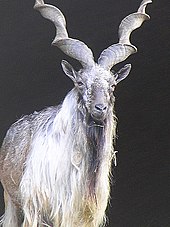|

Wildlife
Pakistan,
with it's diverse landscape has equally varied
wildlife. The mountainous region, with it's abundant
flora/fauna, is home to black and brown bears, snow
leopard, wolf, lynx, otter, Himalaya ibex, markhor, bharal,
marmots and many other animals. The regions in lower
elevations are home to red fox, black bear, Rhesus monkey,
leopard (and other cats), partridge (and other birds).
Unfortunately,
there are also several species that have become extinct or
are endangered - snow leopard, Marco Polo's sheep, brown
bear, musk deer. Although not it's
species isn't extinct, the cheer pheasant is no longer
found in Pakistan, as with the western horned tragopan.
Flora
and fauna

Cedrus deodara, Pakistan's national
tree.
The diversity of
landscapes and climates in Pakistan allows for a wide
variety of trees and plants to flourish in this region.
The forests range from coniferous alpine and subalpine
trees such as spruce, pine, and deodar cedar in the
extreme northern mountains, to deciduous trees such as the
mulberry-type Shisham in the Sulaiman range in the
majority of the country, to palms such coconut and date in
South Punjab and all of Sindh. The western hills are home
to juniper and tamarisk as well as coarse grasses and
scrub plants. Mangrove forests form much of the coastal
wetlands along the coast in the south.
Coniferous forests
in most of the northern and north-western highlands are
found at altitudes ranging from 1,000m to 4,000m. In the
xeric regions of Balochistan, date palms and ephedra are
common floral varieties. In most of Punjab and Sindh, the
Indus plains support tropical and subtropical dry and
moist broadleaf forestry as well as tropical and xeric
shrublands. These forests are mostly mulberry, acacia, and
Eucalyptus.
According to
statistics, 2.5% or about 1,902,000 hectares (19,020
km2) of Pakistan was forested in 2000.
Similar to the
vegetation, the animal life in Pakistan reflects the
varied climatic regions of the land. The southern plains
are home to crocodiles in the Indus while boars, deers,
porcupines, and small rodents are found more commonly in
the surrounding areas. The sandy scrublands of central
Pakistan are home to a jackals, hyenas, wild cats,
panthers, and leopards.

Markhor, Pakistan's national animal
In the north, a wide
variety of animals have found home in the mountainous
regions including the Marco Polo sheep, Urial sheep,
Markhor and Ibex goats, black and brown Himalayan bears,
and the rare Snow Leopard. Another rare species is the
blind Indus River Dolphin of which there are believed to
be about 1,100 remaining, protected at the Indus River
Dolphin Reserve in Sindh.There have been sightings of the
rare Asiatic cheetahs in the southwestern deserts of Sindh
and Balochistan.
Apart from crows,
sparrows and myna, hawks, falcons, and eagles are the more
commonly found birds in Pakistan. A lot of birds sighted
within Pakistan are migratory as they make their way from
Europe, Central Asia and India.
In recent years, the
number of wild animals being killed for fur and leather
trading led to a new law banning the hunting of wild
animals and birds as well as the establishment of several
wildlife sanctuaries and game reserves. The number of
hunters have greatly dwindled since then.
Vast sections of the
Indus flood plains have been cleared of natural vegetation
to grow crops. Only animals like the jackal, mongoose,
jungle cat, civet cat, scaly anteater, desert cat and the
wild hare occur in these areas. Hog deer are found in
riveine tracts. The crop residues and wild growth support
reasonable populations of black and grey partridges.
The lack of
vegetative cover, severity of climatic conditions, and the
impact of grazing animals on the deserts have left wild
animals in a precarious position. Chinkara is the only
animal that can still be found in significant numbers in
Cholistan. The blackbuck, once plentiful in Cholistan, has
now been eliminated; efforts are being made to reintroduce
them into the country. A small number of blue bulls are
found along the Pakistan-Indian border, and in some parts
of Cholistan. Grey partridge, species of sand grouseand
the Indian courser are the main birds of the area. Peafowl
occur in some areas in Cholistan.
|










